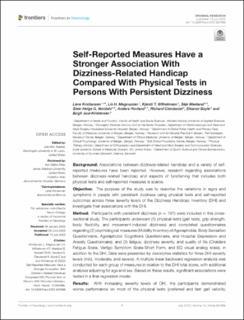| dc.description.abstract | Background: Associations between dizziness-related handicap and a variety of self-reported measures have been reported. However, research regarding associations between dizziness-related handicap and aspects of functioning that includes both physical tests and self-reported measures is scarce.
Objective: The purpose of the study was to describe the variations in signs and symptoms in people with persistent dizziness using physical tests and self-reported outcomes across three severity levels of the Dizziness Handicap Inventory (DHI) and investigate their associations with the DHI.
Method: Participants with persistent dizziness (n = 107) were included in this cross-sectional study. The participants underwent (1) physical tests (gait tests, grip strength, body flexibility, and movement-induced dizziness) and completed questionnaires regarding (2) psychological measures (Mobility Inventory of Agoraphobia, Body Sensation Questionnaire, Agoraphobic Cognitions Questionnaire, and Hospital Depression and Anxiety Questionnaire), and (3) fatigue, dizziness severity, and quality of life (Chalders Fatigue Scale, Vertigo Symptom Scale-Short Form, and EQ visual analog scale), in addition to the DHI. Data were presented by descriptive statistics for three DHI severity levels (mild, moderate, and severe). A multiple linear backward regression analysis was conducted for each group of measures in relation to the DHI total score, with additional analyses adjusting for age and sex. Based on these results, significant associations were tested in a final regression model.
Results: With increasing severity levels of DHI, the participants demonstrated worse performance on most of the physical tests (preferred and fast gait velocity, dizziness intensity after head movements), presented with worse scores on the self-reported measures (avoidance behavior, fear of bodily sensation, fear of fear itself, psychological distress, fatigue, dizziness severity, quality of life). After adjusting for age and sex, significant associations were found between total DHI and avoidance behavior, psychological distress, dizziness severity, and quality of life, but not with any of the physical tests, explaining almost 56% of the variance of the DHI total score.
Conclusion: There was a trend toward worse scores on physical tests and self-reported measurements with increasing DHI severity level. The DHI seems to be a valuable tool in relation to several self-reported outcomes; however, several signs and symptoms may not be detected by the DHI, and thus, a combination of outcomes should be utilized when examining patients with persistent dizziness. | en_US |

